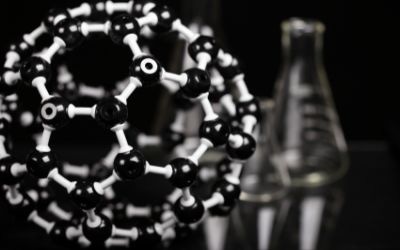Tiny Particles with Big Benefits
May 9, 2011

by Susan D. Brienza, Esq.
Most consumers dont know they are ingesting nanoparticles in foods, energy drinks and dietary supplements because FDA does not require such information be printed on labels. More generally, most people (including purchasers of natural products) are not sure what a nanoparticle is, how small it is, what consumer products contain them, and what health implications they impose. U.S. government agencies cannot even agree on the size of a nanoparticle; no universally accepted regulatory definition of a nanoparticle has been established.
The term nanomaterial, or nanoparticle, describes a particle that has been reduced to the nano level, one-billionth of a meter, or 10 to the minus 9 meters. The size of a nanoparticle ranges from 1 to 100 nanometers; as a comparison, a human hair is roughly 100,000 nanometers in diameter.1 For another visual image: around 300 million nanoparticles, each of them 100 nanometers wide, could fit onto the head of a pin. For a biochemical perspective, the diameter of DNA is in the 2.5 nanometer range, while red blood cells are approximately 2 to 5 micrometers or, as some scientists estimate it, between 2,000 and 8,000 nanometers wide.
Nanotechnology has the potential to revolutionize society. By 2008, nanomaterials were used in more than 600 consumer products. As of 2009, tens of smart cancer drugs, medicines that could zero in on cancer cells while avoiding healthy cells, used nanotechnology at some stage in FDAs pre-market approval process. In 2011, researchers are studying even more ways to use nanomaterials in cosmetics, clothes, renewable energy, cars, electronic instruments, military and defense applications and beyond.
Nanomaterials Improve Foods
Andrew Maynard, chief science advisor to the Woodrow Wilson International Centers Project on Emerging Nanotechnologies (WWIC-PEN), estimated nanoparticles have been used in food products for decades, but we did not realize it because nanotech labeling is not required, so identification of nanofoods depends on self-reporting.2 As early as 2002, nanotechnology was used for chocolate in a process called seed pre-crystallization, which takes pure cocoa butter through processes of shearing and cooling, using micro- and nano-techniques, to produce smaller and more stable crystals, which are then injected into a chocolate mass.3 The result is a more richly colored and shinier chocolate that remains over the shelf life of the product. Nanotechnology is also used in canola oils and other cooking oils.4
Due to an increased surface area, nanocrystalline materials are ultra-high activity chemical catalysts, which means they are widely used in the formation of nanocomposite materials. In general, nanoscale food components can be encapsulated and mixed with other foods in novel combinations. A major new application of the technology could be a time-release mechanism in functional foods that would allow certain molecules to be activated when the bodys levels of a nutrient are especially low. In this way, nanotech would enable a biofeedback process at the molecular level.
Nanotechnology can enhance the vitamin benefit and antioxidant content and promote other various health benefits in functional foods and supplements.5 In one functional food study in 2003, vitamin A, iodine and iron were injected into table saltusing micro and nano techniquesand fed to school children in Morocco.6 Thus, nutrients that had been depleted from the Moroccan soil (and thus absent in the resulting crops) could be administered to children, who then manifested a significant reduction of iodine deficiency and anemia. In addition, certain microcapsules can be tailored to be inserted directly into foods, thus using nanotechnology to meet the nutrition needs of children in various countries and cultures.
As of July 2010, PEN listed 93 food or food-related products using nanomaterials (as identified by the manufacturer) on the global market, mostly in the food packaging category. In the area of food packaging, a new and innovative development is a nano-brick coating that has shown great promise in boosting the barrier properties of plastic food packaging, and also to extend both the shelf life and product quality. Lab studies had shown the nanotech film to be 100 times less permeable to oxygen than existing silicon oxide coatings.7 Thus, this nano-film can keep many foods fresher for longer periods of time. In sum, Nanotechnology has a variety of potential uses in food that may offer health or nutritional benefits to the consumer, and market benefits to the food industry. These include creating foods with the same taste, but lower fat, salt or sugar levels, [as well as] better packaging that keeps food fresher for longer and alerts consumers if the contents have [spoiled], according to a Reuters September 2010 article.8
Supplementing with Nanomaterials
With various biotech innovations, the use of nanomaterials in supplements has increased. As early as 2003, a company filed a new dietary ingredient (NDI) notification with FDA for a new supplement ingredient called Nano Red Elemental selenium (brand name, Nano-Se). This Notification was rejected by FDA, by letter of Aug. 19, 2003, because the agency found the information provided about the chemical identity of the substance was inadequate. Another key reason for FDAs 2003 rejection of this nanoscale selenium was: One referenced study that appeared to use your substance focused primarily on bioavailability and antioxidant effects and not on safety, according to FDA. But since that early rejection, it is clear from label and advertising claims, and on industry news media, nanoparticles and nanomaterials are likely used just as extensively today in dietary supplements as in food packaging and conventional foods.
According to the WWICPENs Consumer Products Inventory, as of 2008, 44 supplements were marketed with claims of nanotechnology use. Twenty-six of these seem to be new in the marketplace since FDAs first public meeting on nanotechnology in October 2006. Then, in 2010, PEN estimated the use of nanotechnology in dietary supplements had tripled between 2007 and 2009, and that this use would grow significantly over the next few years.9 Now, its likely more than 100 nano-supplements are on the global market, but the exact number is impossible to know without nanotechnology label and promotional claims being required by either FDA or FTC.
In supplements, also called nutraceuticals in the marketplace, hence the coined term nanoceuticals, nanoscale materials can make nutrients more bioavailable, and for a sports drink supplement, nanoparticles produce almost instant rehydration, according to one marketer. In terms of making supplements more bioavailable, by 2006 Israeli researchers had uncovered ways to increase the bioavailability of co-enzyme Q10 (CoQ10) in drugs and dietary supplements. Also in 2006, at SupplySide West, a new supplement for blood lipid health was announced, using nanodispersion of policosanol and omega-3, called Nanocosanol (from Valensa). Then in 2007, German-based BASF reported it had used nanotech procedures to solubilizate CoQ10, which resulted in greatly increased bioavailability, especially prominent during the early stages of absorption said the researchers.10
A Todays Dietitian October 2010 article is especially clear on precisely how nanotechnology increases the bioavailability of supplements, focusing on curcumin: Many nutrients and phytochemicals have poor solubility, which decreases their bioavailability. Accordingly, vitamins, minerals and phytochemicals are rarely used in their purest form, and functional ingredients are usually a part of the delivery system. The delivery system functions to transport the nutrient to its desired site while also influencing the supplements taste, texture and shelf life. In theory, nanotechnology overcomes this conundrum by providing a more efficient delivery system with the use of nanoemulsions.
As for agency oversight of such products, FDA issued its Nanotechnology Task Force Report on July 25, 2007, and singled out nanotech foods and dietary supplements as being particularly challenging to monitor and to regulate.
Susan Brienza, Ph.D., is an attorney in the Phoenix-based law firm Ryley Carlock & Applewhite. She practices in the area of regulatory compliance, in food and drug law (including DSHEA) and FTC, advertising law. [email protected] .
References are on the next page...
References for "Tiny Particles with Big Benefits"
1. http://www.nano.gov/html/facts/whatIsNano.html.
2. David Biello. Do Nanoparticles in Food Pose a Health Risk? Scientific American. March 13, 2008.
3. Staff Reporter. Evolution of the nanotech revolution. Confectionerynews.com. March 9, 2007, at 1.
4. Barnaby J. Feder. Engineering Food at the Level of Molecules. N.Y. Times. October 10, 2006.
5. Staff Reporter. Confectionerynews.com. 2007 (above).
6. Ahmed ElAmin. The evolution of the nanotech revolution. Foodproductiondaily.com, March 7, 2007.
7. Rory Harrington. Nano-brick coating most oxygen impermeable film in existence. Food Quality News. March 29, 2011.
8. Compiled by Kate Kelland; editing by Andrew Dobbie. Factbox: Nanotechnology and food. Reuters. Sep 15 2010.
9. Quoted in Stephen Daniells. Nanotech shows promise for anti-cancer nutraceuticals. NutraIngredients-usa. Nov. 15, 2010.
10. Stephen Daniells. CoQ10 emulsions boost bioavailability: study. Nutraingredients.com. April 8, 2008.
11. Jasmin Ilkay, MPH, RD. Nanoceuticals Does Their Potential Outweigh Their Risk? Todays Dietitian. 2010 Oct.;12 (10): 28.
You May Also Like




.png?width=800&auto=webp&quality=80&disable=upscale)